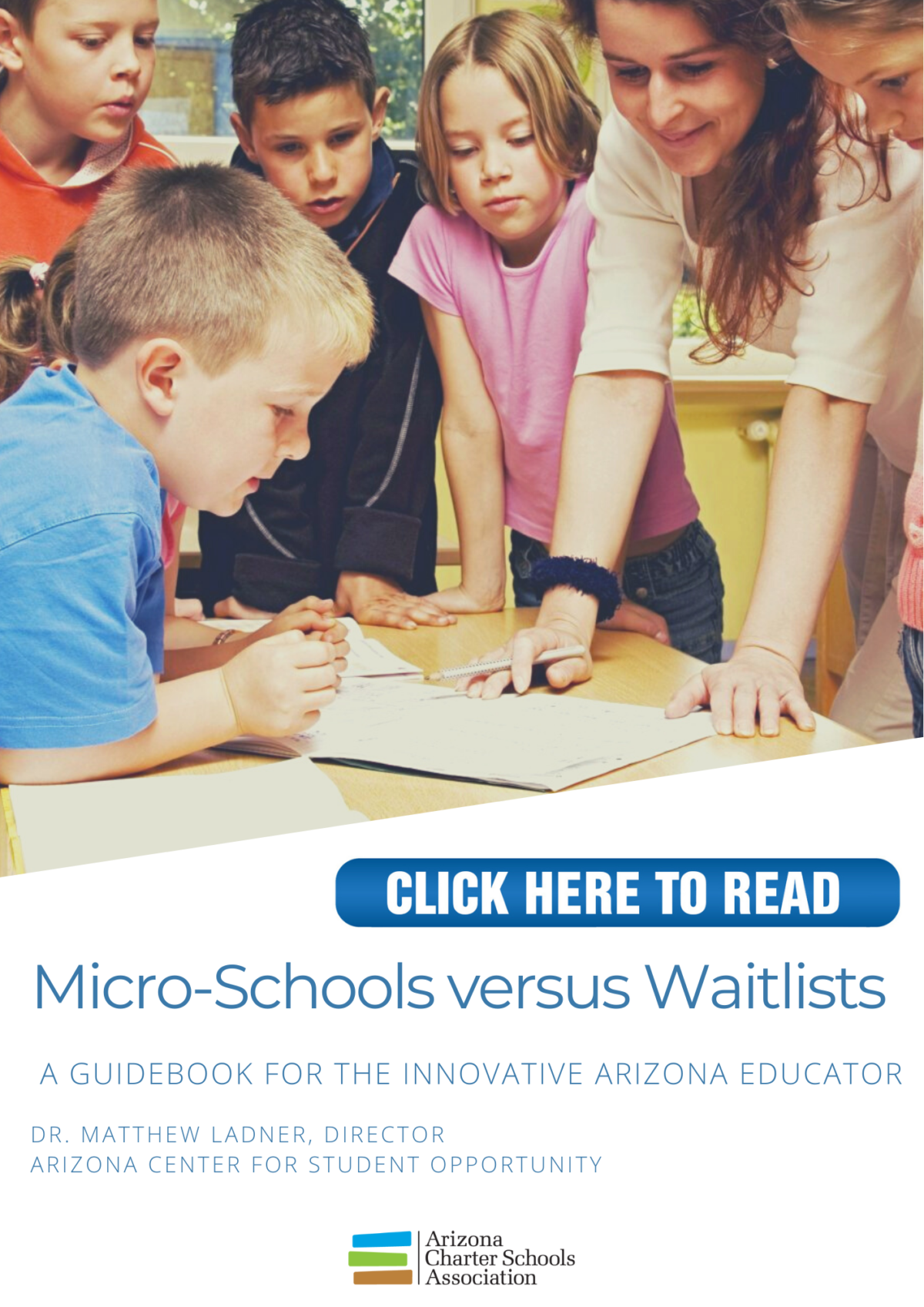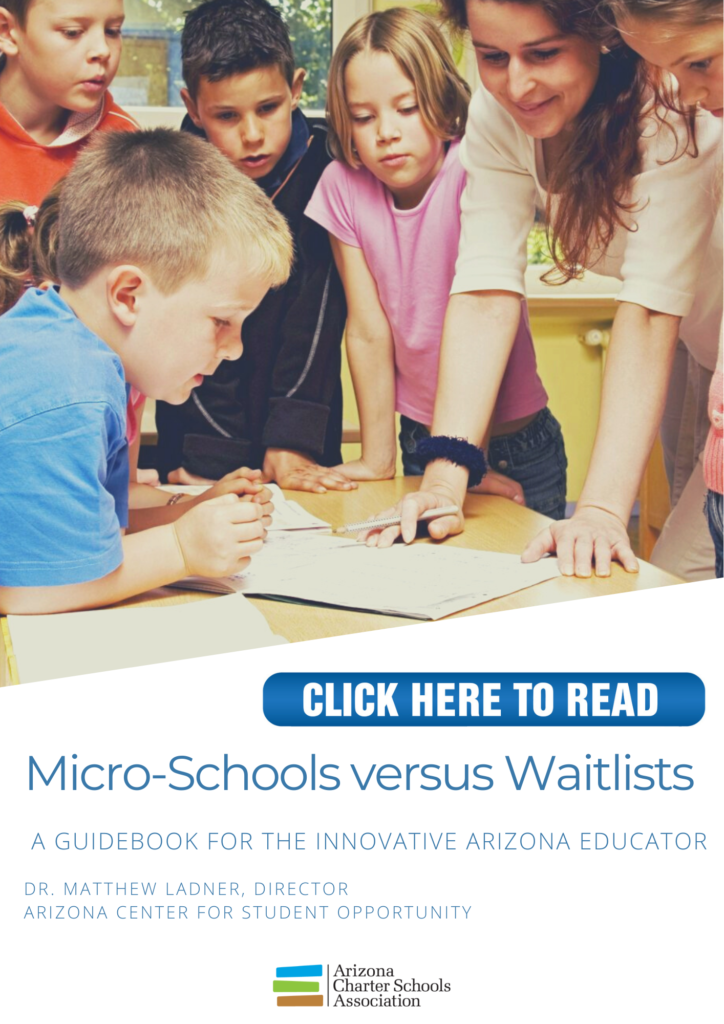“…more innovation has occurred in education in the past few months than perhaps in the entire
preceding decade. Small-group learning pods have taken hold and seen success. Many students
finally have the personalized pace and content they need to learn effectively.”
-Former Secretary of Education Margaret SpellingsBackground: Parent-Organized Discovery Sites (PODS) & High Demand Schools
Educators began exploring the combination of digital learning and small in-person learning communities as a new path to scale before the COVID-19 pandemic.ii Such experiments in the Silicon Valley area during the years leading up to the pandemic led to a rapid nationwide adoption of what would become known as “Pandemic PODS” during the COVID-19 shutdown. This paper is intended to serve as a resource for school operators contemplating this combination of distance learning and small learning communities as a way to serve students currently on their wait-lists.
It is hardly surprising that Arizonans have been at the frontier of this experiment, the state boasting the highest percentage nationally of students attending public charters, but constraints for charter school operators abound, most notably the need to finance facilities out of operating funds either by renting or through construction. The need to finance facilities from operating funds makes the task of hiring and retaining staff challenging for charter school operators. Add to this the reality that Arizona provides an average of $1,200 less per pupil in total funding, and the challenge is more acute. One Arizona micro-school operator however managed to increase enrollment by a factor of six during the pandemic without building new facilities and deliver promising formative assessment data with regards to academic outcomes.
In the Spring of 2020, COVID-19 prompted schools into impromptu versions of distance learning. An uncertain summer followed with delayed and uneven re-openings and often re-closings and a return to in-person learning during the Fall of the 2020-21 school year. While enormous controversy ensued regarding schools and their reopening, during the summer of 2020, parents around the country had responded with adaptive plans of their own in the form of “pandemic pods.”
The pandemic had not only spurred the spontaneous creation of informal micro-schools; the Census Bureau reported that the percentage of students home-schooling doubled between the Spring of 2020 and the following Fall.iv Eighty-percent of pandemic pods met in non-school spaces during the pandemic, with most of the remainder meeting in school spaces that were closed for traditional schooling. Now, innovative operators from around the country are
exploring whether the combination of digital learning and micro-schooling in non-traditional spaces offers a viable path to expanding opportunity for families. Alternatively, one can view “pandemic pods” as a spontaneous social innovation to address the shortcomings of distance learning. Students receive a sense a community with other students and
in-person guidance from an adult. Parents receive custodial care for their children. When paired with a set of curricular projects, small schools can offer an appealing mixture of academic and applied learning.Furthermore, sponsorship by public entities such as schools or districts allows innovative educators to address equity concerns such as paying for staff and ensuring access to technology. Without public sponsorship during the pandemic, large numbers of families bore the out-of-pocket costs, thus creating an equity issue for students whose families could not afford to do so. Sponsorship of pods by public schools allows for such issues to be addressed squarely: families do not need to pay staff or provide technology. Such sponsorship also ensures academic transparency – all students take state mandated academic exams, the results of which count against the sponsoring school’s total.
It is important to note that many families participating in pandemic pods did so as a supplement to digital learning rather than as a replacement for a traditional school.The in-person teacher supported students through academic and technological challenges, also providing custodial oversight and social leadership to small groups of pod students. The task of academic instruction however was shared between remote and in-person instruction. By the Spring of 2021 information had become available concerning teacher interest in PODS, significantly so among public charter school teachers. National surveys also indicate a high degree of interest in varied education options. We now have a very limited but encouraging amount of formative assessment data gathered at pods, and some self-regulatory best practices
already in use in the field. The paper will cover these and other considerations.In exploring the possibility of micro-schools, each potential sponsor must address a number of questions including:
Can this mode of delivery further the organizational mission?
Does my organization have the capacity to operate more than one type of school?
Do we have the technical and human resource capacity to operate micro-schools? If so at what level?
What is the demand for a micro-school associated with the organization?
Only you can answer such questions; however, if you are considering utilizing micro-schools in order to advance your organization’s mission, the document below aims to provide initial resources.
It is expected that the field will ultimately “write the book” on micro-schooling because, as detailed below, while much has been learned about this promising form of education, much more remains to be learned through direct experience.
Micro-schools versus Waitlists: A Guide for the Innovative Arizona Educator



